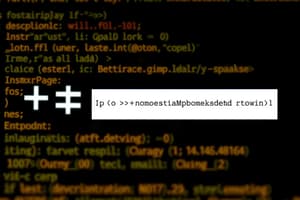Podcast
Questions and Answers
What is the first step to set up the test framework for the CSC 1060 project?
What is the first step to set up the test framework for the CSC 1060 project?
- Run the test suite without configuration
- Compile ProjectTest.h with main.file
- Download ProjectTest.h and place it in the project folder (correct)
- Create a test object without importing any files
Which of the following components is NOT tested by the framework?
Which of the following components is NOT tested by the framework?
- Network connectivity (correct)
- File input/output
- Arrays and vectors
- Function overloading
What should be added to the main.file to initiate the test object?
What should be added to the main.file to initiate the test object?
- ProjectTest test = new ProjectTest();
- TestObject.initialize();
- ProjectTest test = ProjectTest();
- # include "ProjectTest.h" (correct)
When tests are executed, what does a 'FAILED' result indicate?
When tests are executed, what does a 'FAILED' result indicate?
What does the framework specifically test in regards to pointers?
What does the framework specifically test in regards to pointers?
Flashcards
ProjectTest.h
ProjectTest.h
A file that contains the code for the project's classes.
ProjectTest.h
ProjectTest.h
A header file that the framework uses to run tests for specific components of your project.
include statement
include statement
A command that brings in a header file and makes its contents available to your program.
runAllTests()
runAllTests()
Signup and view all the flashcards
Class test placeholder
Class test placeholder
Signup and view all the flashcards
Study Notes
CSC 1060 Project Test Framework
- Step 1: Setting Up
- Download
ProjectTest.hand place it in the project folder. - Include
ProjectTest.hat the top of yourmainfile. - Create a
ProjectTestobject and callrunAllTests()in yourmainfunction.
- Download
Step 2: Understanding the Test Framework
- Functionality Testing
- The framework tests six aspects of your project: classes, file I/O, arrays/vectors, pointers, exception handling, and function overloading.
- Test Output Example
- A sample output shows a "Test Suite", "Testing Class Implementation" section, and a section for adding custom class tests and a summary.
- There's a
FAILEDplaceholder for your class tests until you add your own tests. - The summary shows how many tests passed (0 out of 6 in the example).
Step 3: Adding Your Own Tests
- Testing Your Class
- Find the
testClassFunctionalityfunction inProjectTest.h. - Include your class tests in that function, as in a
studentexample.- Create a student object.
- Check if the student's name is correct.
- Check if the student's age is correct.
- Find the
- Testing File I/O
- The framework includes basic file tests that you can modify for your project.
- Testing Arrays and Vectors
- Add tests for arrays and vectors within your project.
- Testing Pointers
-
- Include tests for using pointers within your project.
Step 4: Running Your Tests
- Compile and execute your program.
- Review the test results.
- Correct any failing tests.
- Re-run the tests.
Common Problems and Solutions
- "Undefined reference..." Error: Verify that the appropriate header files are included and that all class and function definitions are available.
- Tests Failing: Carefully examine the error messages, ensure the code is functioning as expected, and target your tests precisely. Focus on returning or calculating the proper values. Check file handling operations (e.g., permissions, file existence).
Tips for Success
- Start small and add more tests as you progress.
- Test each new functionality immediately.
- Run all tests after each change.
- Correct failing tests before moving on.
- Keep tests well-organized and documented.
Studying That Suits You
Use AI to generate personalized quizzes and flashcards to suit your learning preferences.




